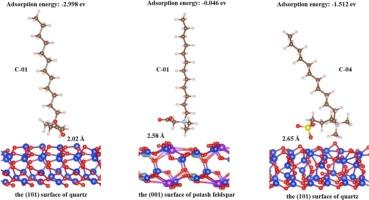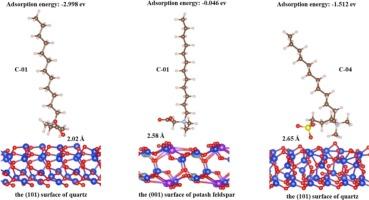从硅酸盐矿物中分离石英的浮选两性表面活性剂:实验和理论的启示
IF 6.9
2区 材料科学
Q2 CHEMISTRY, PHYSICAL
引用次数: 0
摘要
由于晶体结构相似,石英与硅酸盐矿物的有效分离提出了重大挑战。在这项研究中,我们报道了一种石英捕收剂,称为C-01,它包含一个两性基团,用于在pH为7的条件下从各种硅酸盐矿物(包括钠长石、钾长石和蓝晶石)中反浮选分离石英。一系列浮选实验表明,捕收剂C-01对石英表面的吸附具有较高的选择性,达到了测定品位,回收率超过90%。原子力显微镜(AFM)和表面张力测试表明,两性型捕收剂对石英的捕收能力优于传统的混合型捕收剂,表明创新的分子设计可以增强分子内多基团协同效应,优于分子间多基团效应。此外,通过傅里叶变换红外光谱(FT-IR)、zeta电位测量和密度泛函理论(DFT)计算全面研究了捕收剂C-01在石英表面的吸附机理,表明捕收剂C-01通过静电相互作用和氢键选择性吸附在石英表面。总的来说,这项研究为设计具有分子内协同效应的多基团分子作为矿物捕收剂和评估选择性分离过程中的表面相互作用提供了一个有价值的框架,对开发各种工程和环境应用中的新型化学添加剂具有更广泛的意义。本文章由计算机程序翻译,如有差异,请以英文原文为准。


An ampholytic surfactant of flotation separating quartz from silicate minerals: Insights from experiments and theory
Due to the analogous crystal structure, the efficient separation of quartz from silicate minerals presents significant challenges. In this study, we reported a quartz collector, referred to as C-01, which incorporates an ampholytic group for the reverse flotation separation of quartz from various silicate minerals, including albite, potassium feldspar, and kyanite, at a pH of 7. A series of flotation experiments demonstrated that collector C-01 exhibited a high degree of selectivity in adsorbing to the quartz surface, achieving an assay grade and the recovery exceeding 90%. Specifically, atomic force microscopy (AFM) and surface tension tests demonstrated that the collecting capacity of the ampholytic collector surpassed that of traditional mixed collectors for quartz, suggesting that innovative molecular design can enhance the intramolecular multi-group synergistic effect, which is superior to the intermolecular multi-group effect. Furthermore, the adsorption mechanisms on quartz were comprehensively investigated through Fourier-transform infrared (FT-IR) spectroscopy, zeta potential measurements, and density functional theory (DFT) calculations, indicating that collector C-01 selectively adsorbed to the quartz surface via electrostatic interactions and hydrogen bonding. Overall, this research offers a valuable framework for designing multi-group molecules with intramolecular synergistic effects as mineral collectors and for evaluating surface interactions in selective separation processes, with broader implications for the development of novel chemical additives in various engineering and environmental applications.
求助全文
通过发布文献求助,成功后即可免费获取论文全文。
去求助
来源期刊

Applied Surface Science
工程技术-材料科学:膜
CiteScore
12.50
自引率
7.50%
发文量
3393
审稿时长
67 days
期刊介绍:
Applied Surface Science covers topics contributing to a better understanding of surfaces, interfaces, nanostructures and their applications. The journal is concerned with scientific research on the atomic and molecular level of material properties determined with specific surface analytical techniques and/or computational methods, as well as the processing of such structures.
 求助内容:
求助内容: 应助结果提醒方式:
应助结果提醒方式:


